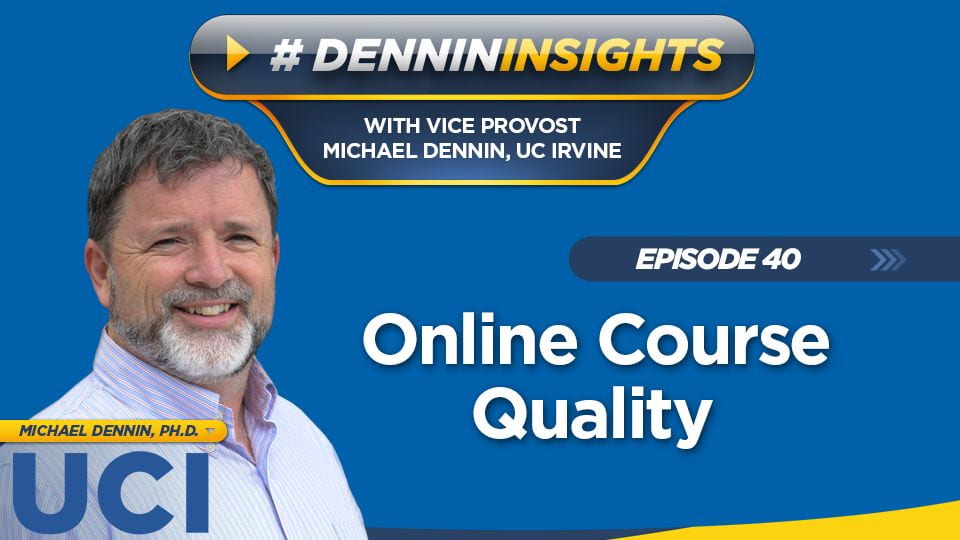Across higher education, there has been a lot of talk about how the pandemic has changed things, especially in regard to technology and course design. It is certainly true that the conversation around online courses has taken on a whole new flavor. Having been involved in undergraduate online course development at UCI since we first started online courses, it is interesting to see the discussion evolve. One topic that seems to be of particular concern is the idea that faculty will end up teaching poorly designed online courses. This concern is showing up in so many different ways that I felt it was worth reflecting on.
First, I want to make it very clear that (1) high-quality online courses take significant effort and planning to deliver; (2) high-quality in-person courses also take significant effort and planning to deliver; and (3) it is potentially easier to deploy a really poor online course than a really poor in-person course.
In regards to points 1 and 2, the difference between the work involved in developing high-quality online versus in-person courses is that most instructors are familiar with creating in-person courses but less familiar with online courses. This can lead to a false sense that quality online courses are harder to develop than in-person courses, when in reality, it is simply a different type of work. So, in one sense, developing quality online courses is considered to be more work only because instructors are less familiar with what this entails.
Let’s now consider my claim that a really poor online course is a bit easier to deploy than a really poor in-person course. Essentially, one can imagine taking a set of video lectures (which many people now have because of the pandemic), some online quizzes and assignments, and declaring this a course. In this example, opportunities for instructor-student and student-student interactions are absent from the course design. This scenario is precisely what many people are concerned might happen. In comparison, even the most poorly designed in-person courses require instructors and students to show up to class, so there is always some minimum level of interaction happening.
But even if we consider this example of a poorly designed online course, it’s very unlikely that courses of this level would be delivered at UCI. In my experience, I’ve found that most faculty take pride in their teaching. They may not have as much time as they would like for it given our current system, but they aim to do the best possible job. In fact, if you look at our current system of course approval and review of faculty and their teaching, there is an inherent assumption that people are committed and doing a good job. We check on this during merit and promotion reviews, and I have not heard a significant concern that faculty purposefully attempt to teach badly. Despite this, there seems to be a growing concern that faculty may elect to teach poorly designed online courses unless we work hard to prevent it.
I may be overly optimistic, but I do not see poor online courses as a viable threat to the UC education process. I have great faith in my colleagues’ desire to offer high-quality education. Therefore, given the three choices: (1) quality in-person courses (with perhaps more technology than before); (2) quality online courses (with support to do the hard work of developing good courses); and (3) poorly designed and executed online courses, I have faith that most with go with option 1 or 2. While some will be tempted by option 3, I would argue this is a small minority of our colleagues. Additionally, we have rules regarding how to address instructors and courses that fall into this category, so it’s not as if they would be allowed to go unchecked.
In our discussions about online courses, we certainly need to communicate best practices, share effective strategies, and offer feedback to help improve course design. But focusing on a perceived danger of poor quality online courses risks becoming a distraction that takes our focus away from the real lessons we learned from the pandemic. For instance, I think a more important lesson is that thinking about our courses and pedagogy on a regular basis allows for continual improvement. In our research efforts, we all aim to stay on top of recent developments and changes to methodology or technological impacts and integrate these changes into our own research practices. One would expect our approach to teaching to be the same.
Online courses generally (and technology more specifically) have changed enough to warrant additional thought and care in implementation. And, as thoughtful people who genuinely care about doing a good job, faculty are certainly ready to put in this effort. Remembering this is why I remain optimistic about the future of online and technology-enhanced courses moving forward.

More online courses would be helpful at least for a student like myself who works a full-time job and attending college.